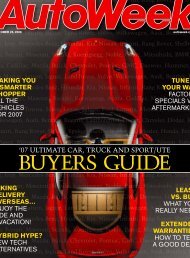SPECIAL EARTH DAY DOUBLE ISSUE - AutoWeek
SPECIAL EARTH DAY DOUBLE ISSUE - AutoWeek
SPECIAL EARTH DAY DOUBLE ISSUE - AutoWeek
You also want an ePaper? Increase the reach of your titles
YUMPU automatically turns print PDFs into web optimized ePapers that Google loves.
commodity. The first one<br />
might have been the original<br />
Beetle, at least in some corners.<br />
The first Rabbit GTi fit<br />
the mold, as do the more recently<br />
introduced New Beetle<br />
and PT Cruiser. All appealed<br />
to some beyond their smallcar<br />
utility. Toyota’s Prius, for<br />
example, probably appeals for<br />
the image it creates as much<br />
as for its hybrid technology.<br />
The current king of image<br />
compacts, at least among<br />
enthusiasts, is the Mini.<br />
Buyers care less that these<br />
cars are inexpensive or economical<br />
to operate and more<br />
that they want the car.<br />
“The Mini has shown you<br />
can give little cars a premium<br />
brand,” says Jim Hall, managing<br />
partner at the industry<br />
analysis firm 2953 Analytics.<br />
“B-cars will have to build a<br />
similar impact on a broader<br />
scale if sales are going to grow<br />
here substantially. They’ll<br />
need a tremendous amount of<br />
character, either through dynamics<br />
or styling. Buyers expect<br />
a payback beyond good<br />
mileage or the entry price.”<br />
Ford’s marketing boss contends<br />
that the Fiesta is there.<br />
“The feedback from [the<br />
Detroit show] was overwhelmingly<br />
good—the look,<br />
the craftsmanship inside,”<br />
Felice says. “Everything<br />
seemed to strike a positive<br />
chord, and we know what this<br />
car does dynamically. We see<br />
Fiesta as a vehicle to aspire to,<br />
rather than a vehicle people<br />
have to buy for the fuel economy<br />
or the price.”<br />
Of course, the unidentified<br />
element behind this could-be<br />
wave of little cars is new<br />
CAFE legislation. A bill<br />
signed by President Bush in<br />
December 2007 raises a manufacturer’s<br />
fleet average at<br />
least 40 percent by 2020, to 35<br />
mpg. It also gives the federal<br />
bureaucracy more teeth to<br />
enforce—and raise—the standard<br />
without legislative intervention.<br />
While car companies<br />
still will be able to buy their<br />
way out with a gas-guzzler tax,<br />
that will be more difficult than<br />
it has been in the last three<br />
decades. Those companies<br />
will have to demonstrate that<br />
they made a genuine effort to<br />
meet the standard and failed.<br />
The new CAFE is anything<br />
but a slam-dunk. And for all<br />
the talk of plug-in hybrids,<br />
E85 and other alternative<br />
fuels, petroleum will remain<br />
the backbone of personal<br />
transportation at least<br />
through 2020. No carmaker<br />
wants to be forced to manage<br />
its mix or to try to manipulate<br />
the market based on its production<br />
capacity or to raise<br />
the price of less fuel-efficient<br />
vehicles to the point where no<br />
one buys them.<br />
Which brings us back to<br />
B-cars. As auto companies<br />
ponder their prospects under<br />
new U.S. CAFE rules (sweating<br />
at least a little), how can<br />
they overlook an option that’s<br />
well developed and in demand<br />
just about everywhere else in<br />
the world?<br />
To that end, and our bene-<br />
fit, carmakers will sweeten<br />
the pot, with more vehicles<br />
based on a B-class footprint<br />
that add interior volume, performance<br />
and appeal. Beyond<br />
the new, stretched Mini<br />
Clubman, BMW is developing<br />
a Mini-based crossover in the<br />
mold of its X3. Volkswagen<br />
America CEO Stefan Jacoby<br />
says his company is considering<br />
a range of B-class VWs for<br />
North America, starting at<br />
about $13,000 dollars and<br />
powered by a turbocharged<br />
1.4-liter four.<br />
Even smaller A-class cars<br />
can’t be far behind. The Smart<br />
car is here, and GM has raised<br />
the prospect of an A-car for<br />
the United States based on its<br />
Beat concept.<br />
Moving up from the small<br />
end, analysts expect B-carsized,<br />
direct-injected turbo<br />
engines (1.2 to 1.4 liters) in<br />
larger cars such as the Civic,<br />
the Cobalt and the Saturn<br />
Astra. Those at the Detroit<br />
show saw Audi’s dieselpowered<br />
R8 supercar and<br />
heard executives talking<br />
about full-size, four-cylinder<br />
pickups and SUVs.<br />
Enthusiasts may bemoan<br />
the politics of CAFE or the<br />
effect the environmental<br />
movement has on their<br />
lifestyle, but the prospects<br />
are interesting. And remembering<br />
that the original Fiesta<br />
lasted only three model years<br />
in the States, we can be sure<br />
that many of these prospects<br />
will fail.<br />
“The possibilities are<br />
fascinating,” says analyst<br />
Hall. “We are heading into<br />
the decade of big changes,<br />
big introductions and big<br />
mistakes.” c<br />
IIIIIIIIIIIIIIIIIIIIIIIIIIIIIIIIIIIIIIIIIIIIIIIIIIIIIIIIIIIIIIIIIIIIIIIIIIIIIIIIIIIIIIIIIIIIIIIIIIIIIIIIIIIIIIIIIIIIIIIIIIIIIIIIIIIIIIIIIIIIIII<br />
OTHER<br />
B-LIEVERS<br />
The Mini, the Aveo and the Fit<br />
(along with the Toyota Yaris, the<br />
Kia Rio and the Nissan Versa) saw<br />
sales rise 30 percent in 2007.<br />
> MINI COOPER > CHEVY AVEO > HONDA FIT<br />
APRIL 21, 2008 AUTOWEEK 23



